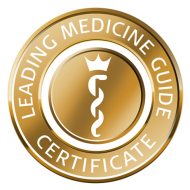The extent of the infarction depends on the size of the blocked vessel. The larger the vessel, the worse the consequences. In the case of a large infarction, the heart can be subjected to such a high level of stress that the circulation collapses. In this case, the danger to life is just as acute as when the infarction is caused by cardiac arrhythmia (ventricular fibrillation). If a heart attack is suspected, the emergency services should be called immediately!
In Germany alone, around 300,000 people suffer a heart attack every year. Unfortunately, the mortality rate is very high – almost half of all patients die before reaching the hospital. This makes myocardial infarction one of the most common causes of death in our country. The risk of a heart attack is higher in men than in women. This is mainly because women have a reduced risk until the menopause thanks to female sex hormones. However, due to the non-specific complaints and the resulting later initiation of the rescue chain, the death rate is higher in women.
The heart muscle, which pumps blood around the human body, is supplied with oxygen and nutrients by the two coronary arteries. If deposits, so-called plaques, form in the arteries, the blood flow is impaired. These residues of connective tissues, blood fats and blood clots build up over many years. There is a risk that the plaque surface will break open and cause a blood clot, which will acutely block the coronary vessel and cause a heart attack.
Doctors refer to the hardening of the blood vessels as arteriosclerosis, the main cause of a heart attack. The disease itself, i.e. the narrowing (stenosis) of the coronary arteries, is referred to as coronary heart disease (CHD). Heart attack patients are often already being treated for angina pectoris (chest tightness), a disease that accompanies CHD. Besides arteriosclerosis, other causes can trigger a heart attack. Even in healthy coronary vessels, a local formation (thrombosis) or the spread (embolism) of a blood clot can lead to a heart attack. Another possibility is vascular spasm (vasospasm).
Heart attacks cannot be completely prevented. However, there are some risk factors that favour heart disease:
- Unhealthy diet – foods with a high energy density and a high fat content lead to obesity
- High cholesterol levels – the formation of plaque is promoted
- Elevated blood pressure – hypertension damages the inner walls of the blood vessels
- Lack of exercise – exercise lowers blood pressure and improves cholesterol levels
- Smoking – cigarettes, pipes and cigars promote the development of plaques
- Diabetes mellitus - Elevated blood sugar levels damage the inner artery walls
- Predisposition – the risk increases if heart disease is in the family
- Gender – men are affected more often than women
- Age – increased risk for men aged 45 and over and women aged 55 and over
Every minute counts in a heart attack, so it is worth knowing the symptoms. It is important to know that the signs differ in the female and male sex. Classic signs of a heart attack are:
- Severe, sometimes burning or pressing pain in the chest that lasts longer than five minutes
- Pain may radiate to the shoulder, arm, upper abdomen or lower jaw
- significantly more severe pain than during an angina pectoris attack, taking the nitrate medication remains ineffective
- Strong feeling of restlessness up to fear of death
- Paleness and cold sweat
- Shortness of breath and dizziness up to unconsciousness
- Nausea and vomiting

Only about one third of women suffer from the typical chest pain during a heart attack. Instead, women report a feeling of tightness in the chest, shortness of breath, nausea and vomiting or pain in the upper abdomen. Around half of all female patients complain of sleep disturbances in the run-up to the heart attack.
Myocardial infarction is not always accompanied by symptoms. The silent or still heart attack is only diagnosed after days or even years and often affects diabetes sufferers.
The most important examination procedure in diagnosing a heart attack is the ECG. Thanks to the electrocardiogram, the location as well as the extent of the infarction can be determined. In the course of the examination, special electrodes are attached to the patient's chest, by means of which the physician, usually a specialist in cardiology can check the heartbeat and the electrical excitation in the heart muscle. This determines whether cardiac arrhythmias are present.
The results also provide information about whether it is an acute heart attack or one that occurred some time ago. Since infarctions cannot always be detected immediately in the ECG, several examinations are carried out at intervals of a few hours if myocardial infarction is suspected.
If no typical changes are visible in the ECG, an ultrasound examination can provide further information about the condition of the heart. In addition, a blood test will be ordered. The dying heart muscle cells release enzymes, which can also be detected in increased concentration in the blood with a slight delay.
A very precise diagnosis is provided by a cardiac catheter examination. In this procedure, a flexible plastic tube is advanced via the leg artery to the heart. A contrast medium is injected through the catheter, which makes heart and vessel structures visible on the X-ray monitor. With this method, an occluded vessel can not only be traced, but also reopened in the same process.
Heart attack patients are taken to the intensive care unit. There, the declared aim is to reopen the blocked coronary artery. There are various procedures for this:
- Lysis therapy – the blood clot is dissolved using lysis medication. However, the medicine does not only affect the heart, but the entire body. Serious bleeding can be the result. Shortly after the heart attack, the chances of the coronary vessel reopening are greatest. Already 12 hours after the heart attack, this treatment method shows hardly any success.
- PCTA – Percutaneous transluminal coronary angioplasty is performed using a cardiac catheter. With the help of a balloon, the affected coronary vessel is dilated so that the blood flow to the heart is restored. Often an additional stent (a small mesh tube) is often implanted in the vessel to prevent it from closing again.
- Bypass surgery – If the changes in the coronary arteries are particularly severe, surgical intervention may be necessary. During bypass surgery, the doctor bridges the narrowing with the help of a vascular graft. Doctors speak of arterial bypass (using part of the chest wall artery) or venous bypass (using a vein from the upper or lower leg).
Arteriosclerosis, the most common cause of myocardial infarction, is best prevented by reducing risk factors. Quitting smoking, eating a healthy and balanced diet and getting enough exercise keep the heart healthy. Overweight people should definitely consider weight reduction. Patients with high blood pressure, elevated cholesterol levels or diabetes mellitus are advised to pay attention to optimal treatment and correct intake of prescribed medication.
















